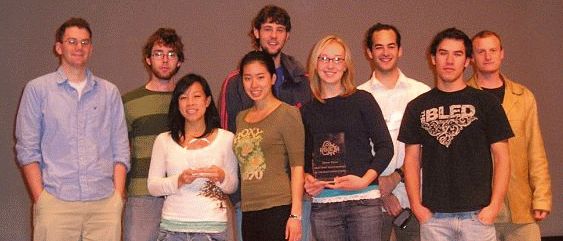University of California Berkeley 2006
From 2006.igem.org
JCAnderson (Talk | contribs) |
JCAnderson (Talk | contribs) |
||
| Line 4: | Line 4: | ||
{| | {| | ||
| | | | ||
| - | <blockquote style="background: moccasin; border: 1px solid rgb(153, 153, 153)"; width="180px"> | + | <blockquote style="background: moccasin; border: 1px solid rgb(153, 153, 153);"; width="180px"> |
<span style='font-size:12.0pt'>Our Team</span> | <span style='font-size:12.0pt'>Our Team</span> | ||
<hr/> | <hr/> | ||
Revision as of 01:45, 12 November 2006
Addressable Conjugation in Bacterial Networks
Networks of interacting cells provide the basis for neural learning. We have developed the process of addressable conjugation for communication within a network of E. coli bacteria. Here, bacteria send messages to one another via conjugation of plasmid DNAs, but the message is only meaningful to cells with a matching address sequence. In this way, the Watson Crick base-pairing of addressing sequences replaces the spatial connectivity present in neural systems. To construct this system, we have adapted natural conjugation systems as the communication device. Information contained in the transferred plasmids is only accessable by "unlocking" the message using RNA based 'keys'. The resulting addressable conjugation process is being adapted to construct a network of NAND logic gates in bacterial cultures. Ultimately, this will allow us to develop networks of bacteria capable of trained learning.
Our Team |
The specific goals of our project were to:
To learn more about our system, follow the series of descriptions below:
High-performance Riboregulators
|
To view our notebooks and protocols, visit our working website at [http://openwetware.org/wiki/IGEM:UC_Berkeley/2006 Berkeley 2006 iGEM]
See our parts list at [http://partsregistry.org/cgi/partsdb/pgroup.cgi?pgroup=iGEM2006partsregistry.org/cgi/partsdb/pgroup.cgi?pgroup=iGEM2006&group=Berkeley Registry 2006 Berkeley iGEM]
Download our Powerpoint presentation

